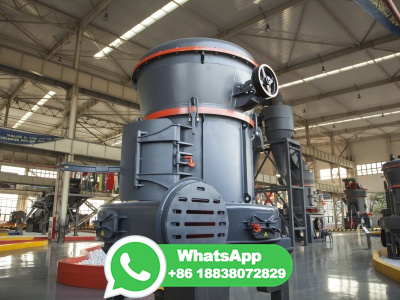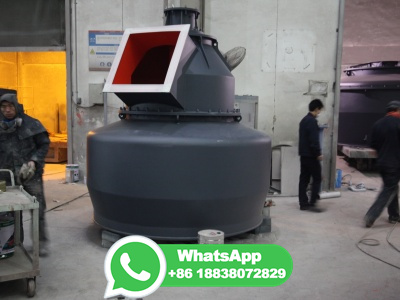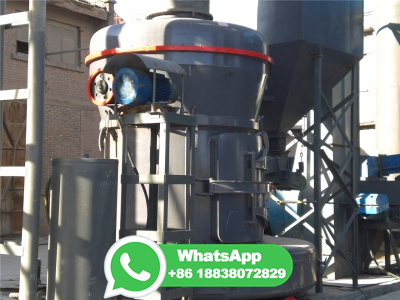
The process of cement production involves the #kiln, a large cylindrical #furnace where raw materials are heated at high temperatures. Coal, along with other fuels such as #petroleumcoke,...
WhatsApp: +86 18838072829
LOW CARBON CEMENT PRODUCTION . ISSUE PAPER . May 20, 2022 . ClimeCo Corporation . One E Philadelphia Ave . Boyertown, Pennsylvania 19512 (484)
WhatsApp: +86 18838072829
Among these three industries, CO 2 emission from cement production in 2000/01 was Gigagram (Gg), contributing 90% only from cement production (MoSTE 2014). Coal is the most used fuel source during the cement manufacturing process in Nepal (Madlool et al. 2013) and contributed to about 50% of CO 2 emissions (Hendriks et al. 2004).
WhatsApp: +86 18838072829
The utilisation of coal in the cement and concrete industries takes three basic forms: 1. As a fuel in the production of cement clinker, 2. Ash produced by burning coal in power stations is used as a component in cement rotary kiln feeds, 3. Ash produced by burning coal in power stations is used as a mineral additive in concrete mixes.
WhatsApp: +86 18838072829
Cement industry is estimated to account for ~67% of anthropogenic CO2 emissions globally. Therefore, the identification of innovative solutions for their mitigation is both a priority and a challenge. The integration of carbon capture and storage technologies into the industrial production process is considered among the most viable solutions for this purpose, and calcium looping (CaL ...
WhatsApp: +86 18838072829
Description of the Cement Manufacturing Process Cement is a finely ground powder which, when mixed with water, forms a hardening ... these combustion units and typically is fueled with coal. Other fossil fuels are generally too expensive to be used for kiln fuel; however carbonbased waste materials (, solvents, oils,
WhatsApp: +86 18838072829
The process relies on "carbon upcycling"—using CO2 emissions captured from industrial activities to produce a cementlike, and potentially carbonneutral, building material. The CO2NCRETE ...
WhatsApp: +86 18838072829
Cement manufacturing is highly energy and emissionsintensive because of the extreme heat required to produce it. Producing a ton of cement requires million BTU of energy, equivalent to about 400 pounds of coal, and generates nearly a ton of CO 2. Given its high emissions and critical importance to society, cement is an obvious place to ...
WhatsApp: +86 18838072829
The cement production process begins with the extraction of limestone and clay from the quarry. The material is then blended, crushed and fed to the kiln. Postkiln, the clinker is cooled and goes through a final grinding method before it is ready to ship. Portland cement, the most common type of cement, is formulated in a variety of strengths ...
WhatsApp: +86 18838072829
Refusederived fuel (RDF) from municipal solid waste (MSW) is an alternative fuel (AF) partially replacing coal/petcoke in a calciner/kiln of cement plant. The maximum thermal substitution rate (TSR) achieved through RDF is 80100% in the calciner, while it is limited to 5060% in the kiln burner. Different AF precombustion technologies, advancements in multichannel burners, and new ...
WhatsApp: +86 18838072829
In this study, a flue gas emission from a cement manufacturing process is considered for development of CO2 capture plant. The cement industry emits approximately 5% of global manmade CO2 emissions.
WhatsApp: +86 18838072829
Cement manufacturing process. The main process routes for the manufacture of cement vary with respect to equipment design, method of operation and fuel consumption [16]. The four basic processes can be classified as follows: ... Fullscale investigations of initial deposits formation in a cement plant cofired with coal and SRF. 2023, Fuel.
WhatsApp: +86 18838072829
Cement manufacturing is a hardtoabate industrial sector that accounts for 58% of global anthropogenic emissions. Approximately 8090% of these emissions occur during limestone calcination and fuel combustion processes.
WhatsApp: +86 18838072829
Cement manufacturing is a complex process that begins with mining and then grinding raw materials that include limestone and clay, to a fine powder, called raw meal, which is then heated to a sintering temperature as high as 1450 °C in a cement kiln. In this process, the chemical bonds of the raw materials are broken down and then they are ...
WhatsApp: +86 18838072829
The dry process of cement manufacturing utilizes GJ of specific energy per ton of clinker production, while the wet process utilizes GJ/t. ... For Indian cement industries, coal fulfils ninetyfour per cent of the thermal energy demand. In contrast, the remaining need is fulfilled by fuel oil and highspeed diesel oil. The cement ...
WhatsApp: +86 18838072829
Cement production is an energyintensive proc ess consuming thermal energy of the order of GJ/tonne of clinker produced, which accounts for 30 40 percent of production costs (Giddings et al., 2000; EC, 2001). Worldwide, coal is the predominant fuel burned in cement kilns. Cement production consumes approximately 120 kg of coal per tonne of ...
WhatsApp: +86 18838072829
The coal should be replaced more with circular materials like crop residues. The more coal is replaced with crop residues, the fewer emissions will be, and the cheaper the cement production process will be, as shown in the sensitivity analysis results of LCA and LCCA. Managerial implications
WhatsApp: +86 18838072829
The balance of domestic cement production is primarily masonry cement. Both of these materials are produced in portland cement manufacturing plants. A diagram of the process, which encompasses production of both portland and masonry cement, is shown in Figure As shown in the figure, the process can be divided into the following primary ...
WhatsApp: +86 18838072829
The manufacture procedures of Portland cement is described below. Mixing of raw material. Burning. Grinding. Storage and packaging. 1. Mixing of raw material. The major raw materials used in the manufacture of cement are Calcium, Silicon, Iron and Aluminum. These minerals are used in different form as per the availability of the minerals.
WhatsApp: +86 18838072829
In the cementmanufacturing process, raw materials are heated to high temperatures in a kiln in a fuelintensive process known as pyroprocessing (Exhibit 2). This results in clinker, small lumps of stony residue that are ground to a powder and combined with other ingredients to produce cement. Exhibit 2 McKinsey_Website_Accessibility
WhatsApp: +86 18838072829
Hence, the coal ash content should be maintained reasonably constant preferably to within about +1 2%. High ash coals, up to 35 or 40% ash content, can be used in cement kilns provided that the ash content is controlled. For coals above about 15% ash content a stockpilereclaim blending system is usually required.
WhatsApp: +86 18838072829
Modern cement was first introduced by Engineer J. Aspdin in 1824 with a production process consisting of three stages: raw material preparation, clinker calcination, and cement production (Xu et al., 2015) ( Rahman et al., 2015 ). Cement production is very energyintensive due to the high temperatures needed in the kilns.
WhatsApp: +86 18838072829
To manufacture 1 t of Portland cement, about to t raw materials, t coal and 1 t clinker (besides other cement constituents and sulfate agents) must be ground to dust fineness during production. In this process, the steps of raw material processing, fuel preparation, clinker burning and cement grinding constitute major emission ...
WhatsApp: +86 18838072829
that were consumed in 2000 for quarrying, cement manufacturing, and concrete production. Cement manufacturing requires very high temperatures, 2,700°F (1,500°C), to initiate the reactions and phase changes necessary to form the complex mineral compounds that give cement its unique properties. Pyroprocessing in
WhatsApp: +86 18838072829
The cement production process is responsible for near 8% ... Most cement kilns today use coal and petroleum coke as primary fuels, and to a lesser extent natural gas and fuel oil. Selected waste and byproducts with recoverable calorific value can be used as fuels in a cement kiln ...
WhatsApp: +86 18838072829
Grinding of clinker consumes power in the range of kWh/ton of clinker produced. These and other pyroprocessing parameters make cement production costly. The pyroprocessing process in kilns and the grinding technologies therefore have to be optimized for best processing. This paper discusses the cement manufacturing and grinding processes.
WhatsApp: +86 18838072829
Cement Clinker CO2 mitigation Kiln Waste Disposal Introduction The cement industry is highly energy intensive, consuming ∼ 15% of total energy demand [1] and responsible for 26% of total industrial CO 2 emissions [2].
WhatsApp: +86 18838072829
A new process developed at MIT could eliminate the greenhousegas emissions associated with the production of cement, the world's most widely used building material and a major source of such emissions. ... which is produced by burning coal. The process produces carbon dioxide in two different ways: from the burning of the coal, and from ...
WhatsApp: +86 18838072829
This article summarizes the arguments surrounding the scientific discussion of the cement production process at a selected company in Slovakia. (1) The main goal of this article is to evaluate the quality of the cement production process with the intention of increasing the performance and quality of the process and the quality of the cement in various assortments. The object of this research ...
WhatsApp: +86 18838072829
Coal is partly converted to ash after combustion in kilns. Coal thus behaves like a raw meal in the kiln. Local coal contains some minor costituents like sulphur, alkalis and chloride which...
WhatsApp: +86 18838072829
To address a decarbonized cement production process (DCPP), a calcium looping process is connected to an industrial cement production process (CPP) for capturing CO2 by ~96%. Since the captured CO2 purity is up to wt%, the carbon capture and utilization (CCU) process is connected to generate the additional products of urea and methanol. An integration of DCPP and CCU, named the DCPP ...
WhatsApp: +86 18838072829